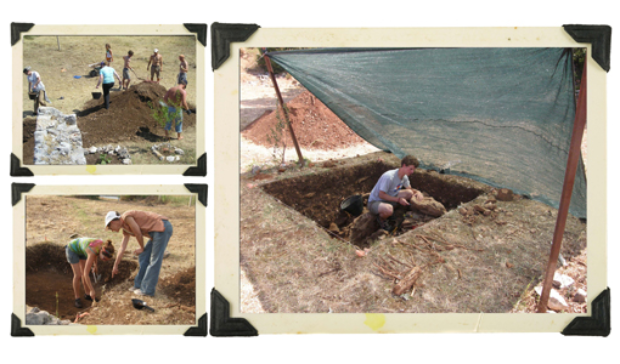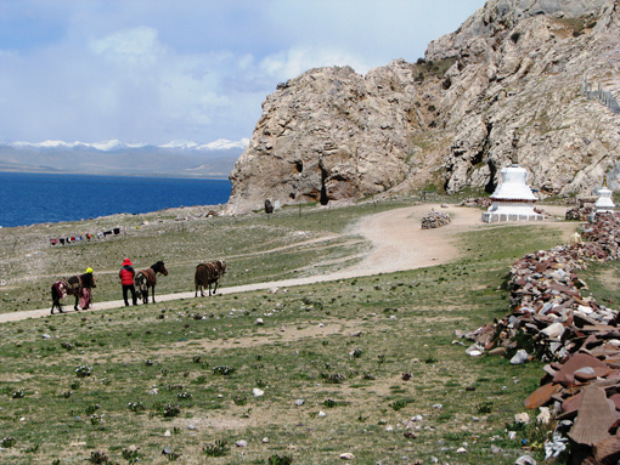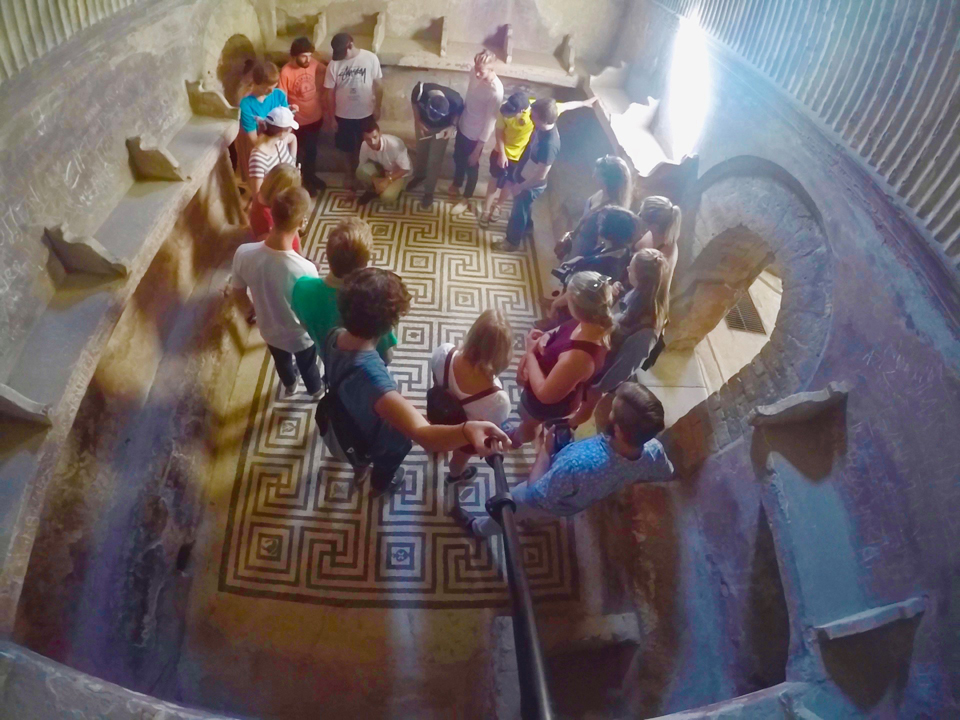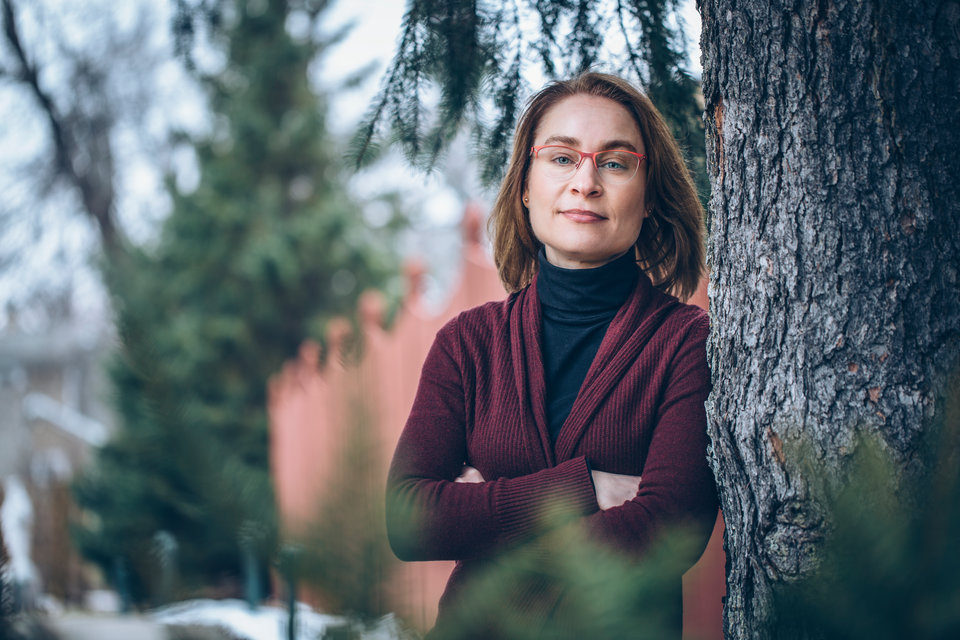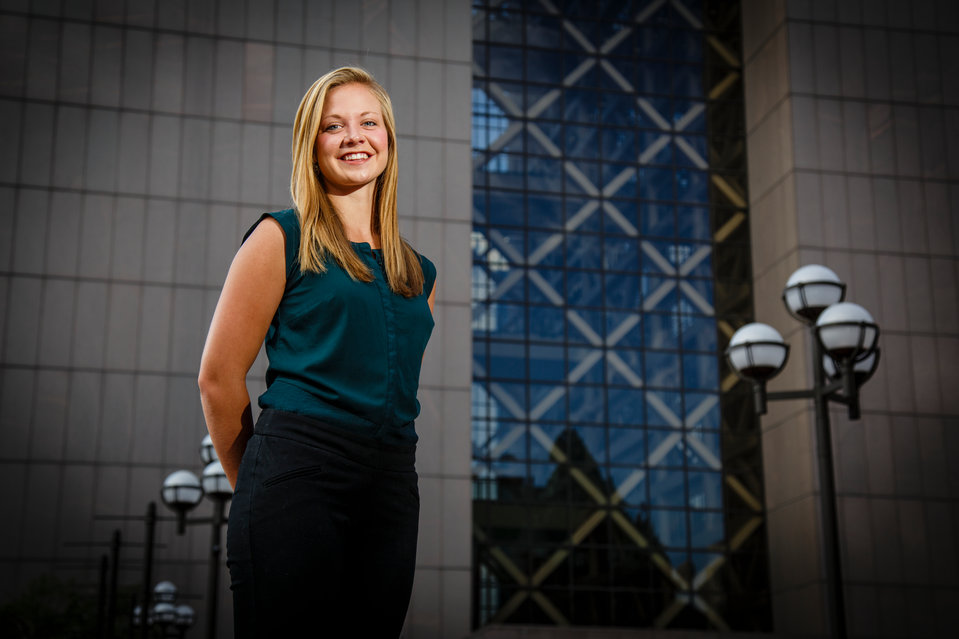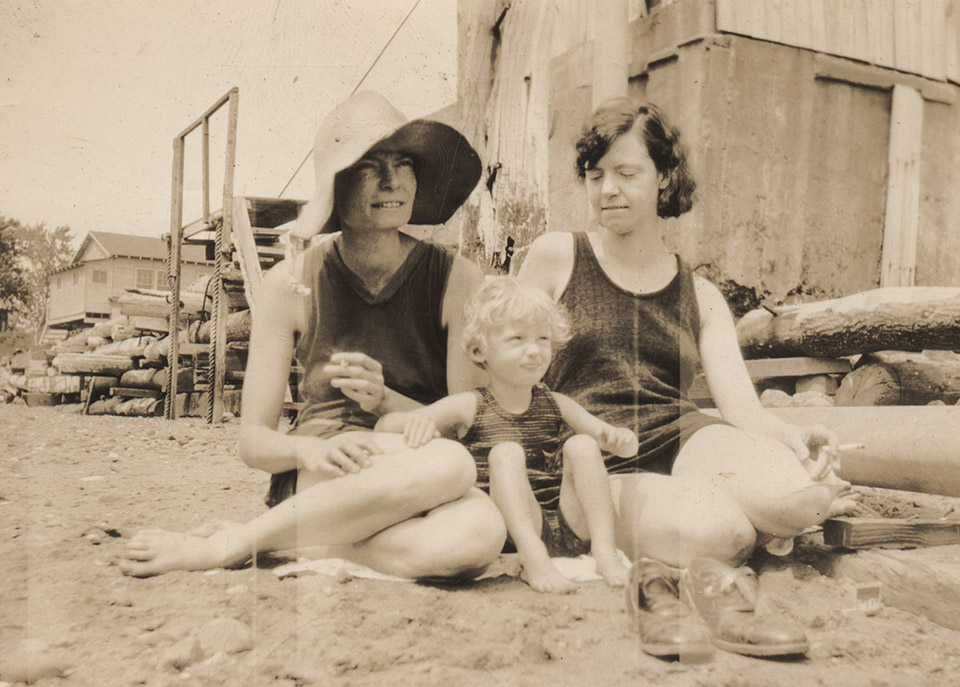A tiny island named St. Clement in the central Adriatic region of Croatia is a treasure with a long history of human activities. There are graves from the Late Bronze Age,traces of Iron Age hilltop forts, pottery imports related to the Greek colonies in the area, and ruins of Roman and Byzantine structures – medieval to modern villages. The sea and land resources sustained life, contacts and travel across centuries.
Last summer an interdisciplinary team composed of St. Thomas students and faculty members collaborated with Croatian, German and Spanish archaeologists in conducting the fourth season of archaeological research at the Roman villa site in the Soline Bay on the south side of the island.
Andrew Herkert, an experienced student of ancient art, archaeology and history, confidently prepared to carry on his internship project in archaeological fieldwork. Cynthia Burton, a freshman with a keen interest in classical art and history, has found her major and minor. She signed up for an independent study of the impact of Greek and Roman colonization on the material culture of the island settlement. A biology major, Joseph Talarico, discovered his passion for history and archaeology and has declared a history minor. Sarah Leonard, a history major and a second-year participant in the project, was a trusted source of practical advice. Two geography majors, Renee Huset and Matthew Weishan, skilled in GPS data collection and GIS studies, already had satellite images from Google Earth and a plan for mapping the island. When they return to the GIS lab they will conduct spatial research of settlement, resources and communications from ancient to modern times.
From the terrace of the village house where the team stayed, we could see a distant view of the St. Clement site. An overview of previous research tells the story: In the geophysical (magnetometry) survey of the site in 2007 we uncovered a complex of walls still buried underground. The next season we cleared dense brush and uncovered ruins of a late Roman building with extensive medieval additions. The test trenches excavated in 2009 confirmed at least two phases of construction, while the pottery finds pushed the date of settlement back to the period of Greek colonization in the third century B.C.
In the last two seasons, several St. Thomas students, all history majors, collaborated with me in making these discoveries. 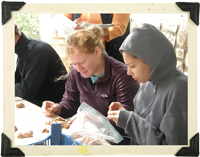 In 2008, Ericka Ashley and Madi Bruber, together with Abby Hitzeman from Gustavus Adolphus College, were our first student-investigators. Bruber was a Young Scholar whose project was to study the impact of the Byzantine-Gothic wars in the Adriatic in the sixth century, known from historical sources, on the life and economy of the site. Considering the pottery finds from the first season and some standing structural remains, that period was especially prosperous on the island. Bruber successfully presented her research at the 2009 Missouri Valley History Conference in Omaha.
In 2008, Ericka Ashley and Madi Bruber, together with Abby Hitzeman from Gustavus Adolphus College, were our first student-investigators. Bruber was a Young Scholar whose project was to study the impact of the Byzantine-Gothic wars in the Adriatic in the sixth century, known from historical sources, on the life and economy of the site. Considering the pottery finds from the first season and some standing structural remains, that period was especially prosperous on the island. Bruber successfully presented her research at the 2009 Missouri Valley History Conference in Omaha.
She participated again in 2009 with Jonathan Estes and Sarah Leonard. Estes’ independent research project focused on the submerged salt works in Soline Bay, as an important part of St. Clement’s sea economy in the context of Roman provincial specialization of imperial economy. His underwater investigations documented the layout and dimensions of the walls that divided salt pans, which were barely visible in the sea on the aerial photos of the bay taken in 2008. The sea level in the eastern Adriatic region has risen 2 meters since antiquity, and many coastal structures are totally or partially submerged. My sister, Vlasta Begovic, the project architect, and I have been studying for years Roman maritime villas and the impact of sea level on their architecture.
I enjoy sharing the excitement of discovery with students in the classroom, but more so in the field. We could hardly wait to get to the site. Anticipation of new findings on a tiny island, once a speck of land in the internal sea of the Roman Empire, was contagious.
This 2010 season was more ambitious. Our team of art history, geography and history students collaborated with international professionals and volunteers in investigating the site in the context of the island’s archaeology. The archaeology of islands and coastal landscapes is an established methodological perspective that calls for an interdisciplinary approach. The ancient settlement in Soline Bay was our focus of research, but knowledge of the landscape and seascape of St. Clement was essential to our understanding of the way of human life and of historical contacts and changes. Our 15 days of research in the field provided important data on the role of the site in the Greco-Roman network and on the topography and environment of the island.
The centrality of the Adriatic Sea for travel and exchange between the Mediterranean and European societies conditioned the life and economy of the islanders.
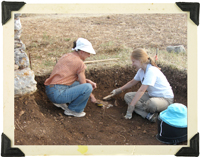 Our research questions were focused on classical antiquity. How did the Greeks and Romans socialize the central Dalmatian seascape? What resources did they use and how did they design their settlements?
Our research questions were focused on classical antiquity. How did the Greeks and Romans socialize the central Dalmatian seascape? What resources did they use and how did they design their settlements?
Funding for the project came again from the Archaeo/ Community Foundation, while the much appreciated St. Thomas support came from the Grants and Research Office, the departments of Art History, Geography and History, and from the College of Arts and Sciences.
My excitement of the fieldwork brought back memories of my participation as a student of archaeology in the excavations of Emperor Diocletian’s palace in Split, Croatia. The impact of that experience shaped my interest in Roman archaeology and history. It also changed my life, as I met Tom Schrunk, the project photographer then and now, and moved to Minnesota. It was not a coincidence that our first group meeting in Croatia was within the walls of Diocletian’s palace. From Split, our team took a boat to the island of Hvar, and a taxi boat to St. Clement. Our project codirector Marinko Petric from the Heritage Museum of Hvar, the collaborating institution, met us there.
Our typical day on St. Clement started with a group breakfast on the terrace overlooking the bay of Soline with a clear view of our site. Ready for the morning work and loaded with excavation tools, we took a short walk downhill on the path between pine trees, and then meandered through tall grass at the head of the bay. A shortcut through a vineyard worked better when we left the site in the noon heat to have lunch at the restaurant appropriately named Dionis (Dionysus). The local family owners are great supporters of our project and important sources of oral history of the island. Refreshed by swimming during a mid-day break, we tracked to work until the setting sun called us back to Dionis.
We spent the first two days clearing the site of grass and thick brush with a power trimmer and many helping hands protected by leather gloves. 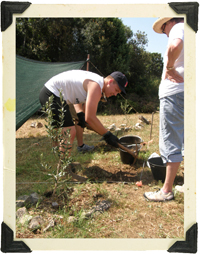 One local helper used his chain saw on small trees. A team of two archaeologists, Felix Teichner from the University of Frankfurt and Jesus Chaparro from Spain, surveyed the freshly cleared areas with a magnetometer and then mapped the entire site and set up a grid. Two 2-by-2-meter trenches, or test pits, were set up within the grid in the areas where the results of the survey showed intersecting walls from supposedly two different phases of construction, because the walls had different orientations. Picks and shovels were good to remove the topsoil, but trowels and small handpicks were used for excavating underlying deposit layers and any cultural features, like walls and mortar subfloors, or artifacts.
One local helper used his chain saw on small trees. A team of two archaeologists, Felix Teichner from the University of Frankfurt and Jesus Chaparro from Spain, surveyed the freshly cleared areas with a magnetometer and then mapped the entire site and set up a grid. Two 2-by-2-meter trenches, or test pits, were set up within the grid in the areas where the results of the survey showed intersecting walls from supposedly two different phases of construction, because the walls had different orientations. Picks and shovels were good to remove the topsoil, but trowels and small handpicks were used for excavating underlying deposit layers and any cultural features, like walls and mortar subfloors, or artifacts.
We carried the excavated soil in buckets to a sifting site, where two people worked at the sieve and recovered every trace of human activity. Our excavation yielded many small shards of fine and coarse pottery, mostly tableware and tall jars (amphorae), but also numerous white stone tesserae for mosaic floors and fragments of roof tiles and bricks and occasional pieces of glass vessels. We found two fragments of Roman bronze pins (fibulae) and a corroded late Roman bronze coin. Ceramic and stone artifacts were washed in water, but metal and glass required special cleaning.
All the finds needed to be properly labeled and recorded in regard to the spot where they were found and the context. Keeping a detailed journal and taking photographs and calculating levels with a surveyor’s tool (theodolite) of every stratigraphic unit and feature were daily routines under the supervision of our Croatian field director, Marina Ugarkovic. Recovering, processing and documenting archaeological data, especially pottery washing, were slow and tedious but essential processes in every field project. Students and volunteers rotated tasks, but digging was most popular. Finding buried remains of ancient societies was irresistible.
Geography students Huset and Weishan collected data while on daily walking trips. They surveyed topographical features and located positions of many cultural and natural resources, ancient and modern. They walked almost the entire rocky coastline of the island and followed all pathways, even those abandoned and overgrown, often returning scratched and exhausted. Still, they took part in the archaeological work during a few available hours.
In Huset’s words: “Working in the field with only a GPS device, a computer back at the excavation house and very little electricity were great learning experiences that could not have been replicated in any classroom. The whole experience – from traversing the rocky coast to getting a crash course in Roman pottery – was intense but also very exciting and a lot of fun. Meeting the locals, working with international researchers and enjoying the beautiful island made for an excellent three weeks of fieldwork.”
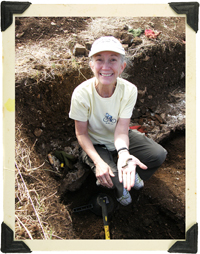 Archaeology is one of the most fascinating and stimulating field-based disciplines. It depends on the application of skills from a range of disciplines and the fieldwork is therefore rewarding for interdisciplinary student-faculty research collaboration. Our research community included multicultural professionals and volunteers of different ages, professions and skills. Volunteers were: Gordana Berc, Croatia; Ivo Crnkovic-Rubsamen, New York; Gaby Garbasz, New York; Tom Lumsden, Calif.; Jane Nosan and Barbara Shank, dean of the School of Social Work at the University of St. Thomas.
Archaeology is one of the most fascinating and stimulating field-based disciplines. It depends on the application of skills from a range of disciplines and the fieldwork is therefore rewarding for interdisciplinary student-faculty research collaboration. Our research community included multicultural professionals and volunteers of different ages, professions and skills. Volunteers were: Gordana Berc, Croatia; Ivo Crnkovic-Rubsamen, New York; Gaby Garbasz, New York; Tom Lumsden, Calif.; Jane Nosan and Barbara Shank, dean of the School of Social Work at the University of St. Thomas.
The social atmosphere and interactions in the field engaged students as active participants in the culture of archaeological research. They had opportunities for authentic learning as they acquired knowledge in archaeological thinking and practices.
Weishan reflected on his experience: “The team was beyond diverse – among the dozen of us, five nationalities were represented – as well as countries outside the U.S. This facilitated a globally fueled exchange of ideas, theorem and practices in terms of archaeological activity. The leadership on the island created a tightly knit student workforce and also did wonders for providing further opportunities for learning beyond our own excavations.”
Our hopes of finding some solid evidence for the importance of this island, unnamed in Greek and Roman sources, materialized in both test trenches. The findings of decorated Greek pottery indicated that our site was of some significance already in the Greek colonial network, probably due to the fertile valley and its location on the navigation routes. Two islands in the immediate vicinity of St. Clement, Vis and Hva (Greek Issa and Pharos), had colonies of Greek settlers. Wine and olive oil were their cash crops, which continued unchanged into the Roman period. The Greeks were seafarers, traders and colonizers. They incorporated the Adriatic into their mythological landscape of the Mediterranean, giving spiritual power to some islands and coastal markers crucial for navigation. Shrines of the Trojan hero Diomedes have been located archaeologically at two such sites in central Dalmatia. Votive offerings of inscribed pottery told the story. Our Croatian project director, Branko Kirigin, who uncovered those shrines, told us this story in the field one morning.
The Romans colonized the inhabitants of the occupied territories, developed agricultural and natural resources on a large scale, and tied them to the imperial economy. A fragment of a mosaic made of imported, green marble confirmed our expectations that the site could have been the center of one such large estate with residential and farm buildings next to vineyards and olive orchards. The shallow bay, ideal for salt production, was used for salting sardines and making fish sauce, and was valued as an exchange commodity.
Much more work is ahead. Intellectual and social rewards of another successful season will keep us going. Herkert said it well: 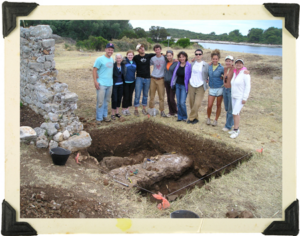 “Ultimately, what I walked away with is a strengthened understanding of classical archaeology in practice, a far greater professional network and a wholly redefined enthusiasm for my aspirations as an art historian.”
“Ultimately, what I walked away with is a strengthened understanding of classical archaeology in practice, a far greater professional network and a wholly redefined enthusiasm for my aspirations as an art historian.”
Read more from CAS Spotlight
